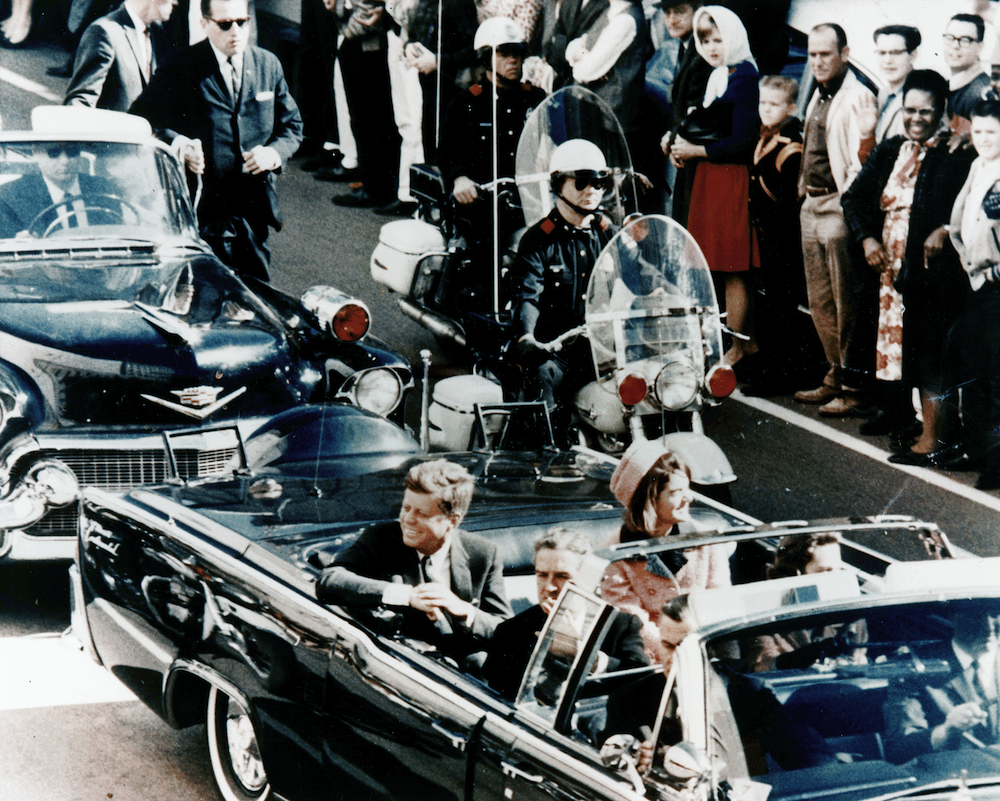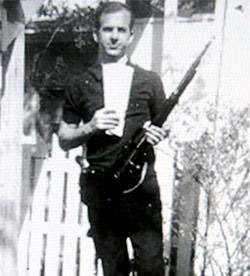Facts About the JFK Assassination

John F. Kennedy, 35th president of the United States, was assassinated on Nov. 22, 1963, in Dallas. The official investigation found that Lee Harvey Oswald, acting alone, shot Kennedy from a warehouse window overlooking the president's motorcade route. Nevertheless, conspiracy theorists have speculated over the years that the full story has not been told. Some believe that classified documents held by the National Archives may identify the "real" killer of the president.
In 2017, the National Archives released 2,800 documents previously withheld from the public. However, no new information was unveiled, although President Donald Trump withheld about 300 documents for further review. This was done at the request of several intelligence agencies that sought to avoid compromising national security, law enforcement or intelligence-gathering methods, according to The New York Times. The remaining documents are to be released in late April.
Here is a review of the facts about Kennedy's last day and the aftermath.
Campaign trip
In September 1963, Kennedy began traveling to various states to bolster his run for a second term. He visited Massachusetts and Pennsylvania in October, and Florida and Texas were next on the itinerary, according to the John F. Kennedy Presidential Library and Museum.
On Nov. 21, the president and the first lady, Jacqueline Kennedy, boarded Air Force One for Texas. The plan was to visit for two days and to travel to five cities in the Lone Star State. The president's first stop was San Antonio. Vice President Lyndon B. Johnson, Texas Gov. John B. Connally and Texas Sen. Ralph W. Yarborough accompanied Kennedy to Brooks Air Force Base for the dedication of the Aerospace Medical Health Center. Next, Kennedy arrived in Houston to speak to a Latin American citizens' organization and at a testimonial dinner for Rep. Albert Thomas.
From Houston, Kennedy traveled north to Fort Worth, Texas. On the morning of Nov. 22, Kennedy spoke to the Fort Worth Chamber of Commerce at breakfast. "We are still the keystone in the arch of freedom," he told those in attendance. "We will continue to do … our duty, and the people of Texas will be in the lead."
The assassination
After breakfast, the presidential party flew to Dallas. The trip took just 13 minutes, and Air Force One arrived at Love Field airport at 11:37 a.m. After getting off the plane, Kennedy and his wife shook hands with the crowd that awaited them.
Get the world’s most fascinating discoveries delivered straight to your inbox.
Then, the presidential couple joined Connally and his wife, Nellie, in an open convertible. The car was a custom-made, reinforced parade limousine built in Wixom, Michigan, in January 1961 by the Ford Motor Company. The Secret Service leased the car for $500 per year, according to the Henry Ford Museum of American Innovation. The Secret Service gave the car the code name of X-100.
X-100 and the rest of the procession left the airport and traveled 10 miles (16 kilometers) through downtown Dallas. The destination was intended to be the Trade Mart, where the president was scheduled to speak. He never made it that far.
Along the route, crowds lined the streets to get a glimpse of the Kennedys. According to a map of the motorcade route from the Dallas Municipal Archives, the motorcade turned off Main Street at Dealey Plaza to Houston Street. The X-100 had traveled only 7.7 miles (12 km) from the airport when it passed the Texas School Book Depository on Elm Street at 12:30 p.m. At this moment, someone shot at the car.
Connally was hit in the chest with one bullet, which broke ribs, punctured a lung, broke one wrist and ended its journey in one of Connally's leg.
The president was shot once in the neck and once in the head. He then slumped over toward Mrs. Kennedy. The president and Connally were rushed to Parkland Memorial Hospital just 3.4 miles (5.5 km) away. At 12:36 p.m., the ABC radio network broadcasted that the president had been shot, and at 12:40 p.m., the CBS television network broadcasted the first nationwide TV news bulletin about the shooting, according to CNN.
A Catholic priest administered last rites for the president, and at 1 p.m., Kennedy was pronounced dead at the age of 46. Soon after, his body was taken back to Air Force One at Love Field in a bronze casket, accompanied by his wife and the vice president.
The manhunt
At 1:15 p.m., approximately 45 minutes after the assassination, Oswald, a recently hired employee at the Texas School Book Depository, killed Dallas Police patrolman J.D. Tippit. Not long after, at around 2:15 p.m., police officers arrested Oswald in the back of a movie theater and held him for the assassination of Kennedy and the fatal shooting of Tippit, according to the JFK library.
At 2:38 p.m., just an hour and 38 minutes after Kennedy was pronounced dead, Vice President Johnson took the oath of office inside Air Force One. After the flight back to Washington, Kennedy's body was taken to Bethesda Naval Hospital for an autopsy. The next morning, the body was transported to the East Wing of the White House.
On Sunday morning, Nov. 24, Oswald was being transferred from police headquarters to the county jail. The event was broadcast on live television across the country. Suddenly, a man named Jack Ruby, a local nightclub owner, fired a pistol at Oswald at point-blank range. Just 2 hours later, Oswald was pronounced dead at Parkland Hospital, the same hospital where the president had died.
Nov. 24 was also the day of Kennedy's procession in Washington, D.C. His flag-draped casket, pulled by six gray horses and accompanied by one riderless black horse, traveled from the White House to the Capitol Rotunda, where he lay in state for 21 hours; around 250,000 people paid their respects.
Kennedy was laid to rest on Monday, Nov. 25, 1963, in Arlington National Cemetery during a funeral attended by heads of state and representatives from more than 100 countries. An eternal flame was lit beside the grave. President Johnson declared Nov. 25 a national day of mourning.
On Nov. 26, Ruby was indicted in Dallas for the murder of Oswald and was later convicted. His conviction was overturned on appeal, but Ruby died of cancer in 1967 before he got a new trial.
The investigation
Just a week after the assassination, on Nov. 29, Johnson started a commission to evaluate the assassination of Kennedy and the killing of Oswald. The president named Chief Justice Earl Warren as chairman of the President's Commission on the Assassination of President Kennedy, which became better known as the Warren Commission.
The commission's job was to collect information and report back to Johnson. The Warren Commission Report, which can be read at the National Archives website, concluded that "the shots which killed President Kennedy and wounded Governor Connally were fired from the sixth-floor window at the southeast corner of the Texas School Book Depository." It also said, "The shots which killed President Kennedy and wounded Governor Connally were fired by Lee Harvey Oswald."
Conspiracy theories
Many theorists don't buy the "lone-gunman theory." Instead, they suspect that Oswald, a former U.S. Marine, didn't act alone — that he had ties to the Mafia or to Cuba or to the Soviets or to the CIA. None of the claims have ever been proven. [Related: Incriminating Photo of Lee Harvey Oswald Not Faked]
There have been allegations that the Warren Commission didn't get the full cooperation of federal agencies during its investigation. In light of those allegations, the U.S. House of Representatives created the House Select Committee on Assassinations in 1976 to reopen the investigation. The committee found "a high probability that two gunmen fired" at the president. That claim was based on a Dallas police radio-transmission tape on which some said that four or more shots could be heard being fired in Dealey Plaza, according to the JFK library.
Acoustic experts found this to be false after analyzing the tape of the shooting.
Document release
In 1992, with the President John F. Kennedy Assassination Records Collection Act, Congress ordered all assassination-related material to be housed together under supervision of the National Archives and Records Administration and ordered that the material be released to the public 25 years later.
In 2017, the National Archives released 2,800 documents. The collection includes 5 million copies of photographs, records, videos, sound recordings and artifacts. It takes up approximately 2,000 cubic feet (5.7 cubic meters). Before this release, 88 percent of the files had already been available to the public since the 1990s, according to the National Archives.
Trump kept around 300 files classified, though. He said that they could be a concern for U.S. national security.
The new documents, greatly rumored to hold secrets about the "real" killer of the president, contained very little new information, to the disappointment of conspiracy theorists.
"Ultimately, people have always shared these theories because they are interesting — truthfulness and accuracy are less important and often incidental," said Ken Drinkwater, senior lecturer and researcher in cognitive and parapsychology at Manchester Metropolitan University in England, and Neil Dagnall, reader in applied cognitive psychology at the same university. [JFK Assassination Files Due for Release: Why Conspiracy Theorists Are Excited]
Researchers have reported that this "treasure trove" consists of raw files and handwritten notes and is "a mess," according to Larry J. Sabato, the founder and director of the Center for Politics at the University of Virginia, who wrote about the documents for The New York Times. Assembling the puzzle pieces into something useful or credible will take a lot of time, he wrote.
Additional resources




